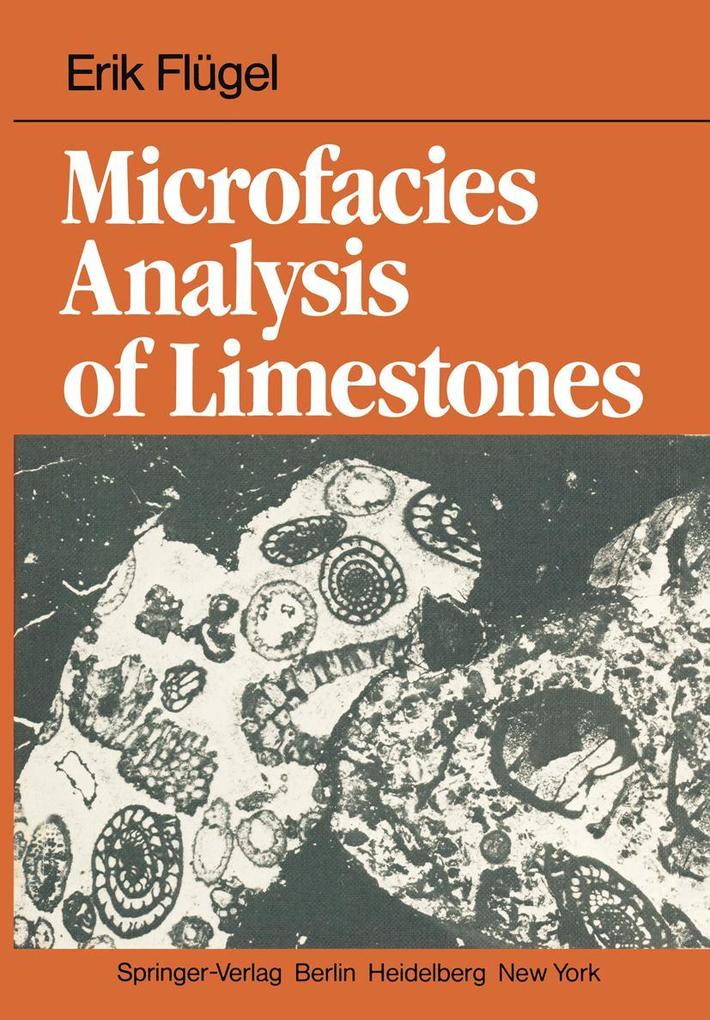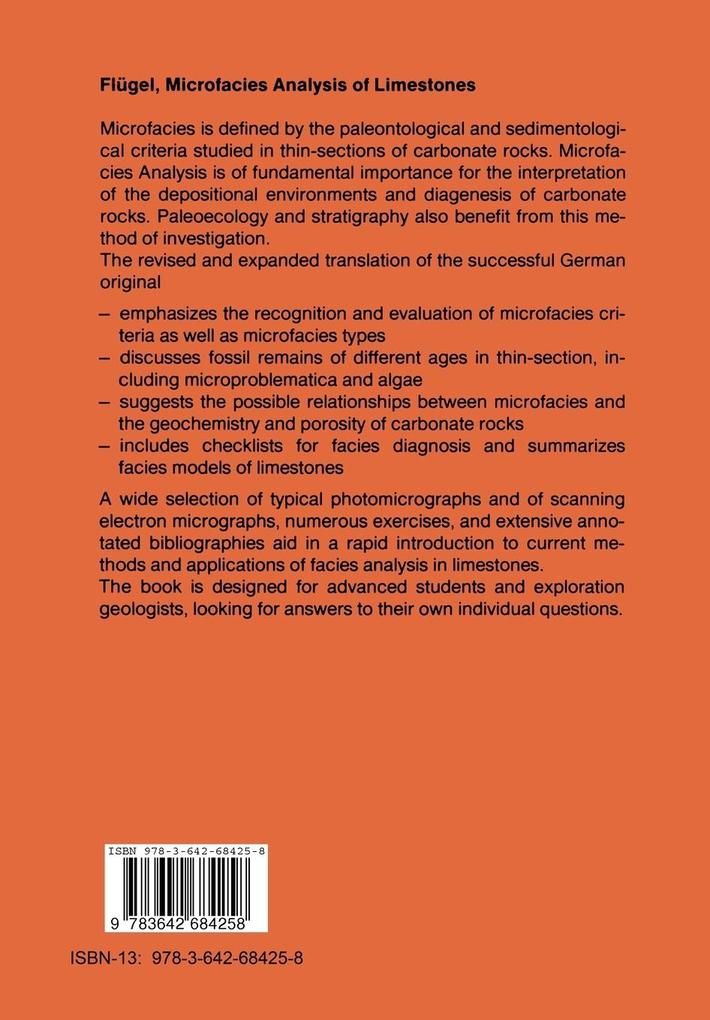1 Introduction to Fades Analysis.- 1.1 The Microfacies Concept.- 1.2 Methods of Facies Analysis.- 1.3 References.- 1.4 Supplementary Reading.- 2 Recent Carbonate Sedimentation.- 2.1 Carbonate Mineralogy.- 2.2 Carbonate Sedimentation in Marine Environments.- 2.3 Lacustrine and Terrestrial Carbonate Sedimentation.- 2.4 References: Recent Carbonate Sedimentation.- 3 Carbonate Diagenesis.- 3.1 Diagenetic Environments. Classification of Diagenetic Processes.- 3.2 Carbonate Destruction.- 3.3 Cementation.- 3.4 Sparite and Microsparite Terminology.- 3.5 Lithification of Lime Mud.- 3.6 Compaction.- 3.7 Stylolites.- 3.8 Calcite Veins.- 3.9 References: Carbonate Diagenesis.- 4 Microfacies Characteristics.- 4.1 "Groundmass" and Particles.- 4.2 Textural and Structural Criteria.- 4.3 Frequency Analysis (Constituent Analysis).- 5 Fossils in Thin-Sections.- 5.1 General Survey.- 5.2 Key to Identification.- 5.3 Selected Groups of Organisms.- 5.4 Microfacies Zones (with References).- 5.5 Annotated Bibliography: Microfacies Monographs.- 6 Classifications of Carbonate Rocks.- 6.1 Principles of Classification.- 6.2 Systems of Classification.- 6.3 Discussion and Examples.- 6.4 References: Classification of Carbonate Rocks.- 7 Microfacies Types.- 7.1 Prerequisites.- 7.2 Qualitative Categorization.- 7.3 Quantitative Categorization.- 7.4 Checklist for Microfacies Studies.- 8 Standard Microfacies Types.- 8.1 Principles.- 8.2 SMF Types.- 8.3 SMF Types and Facies Belts.- 8.4 Discussion and Examples.- 8.5 References: Standard Microfacies Types.- 9 Complementary Methods.- 9.1 Relationship Between Microfacies and Geochemical Criteria.- 9.2 Relationship Between Microfacies and Physical Criteria.- 9.3 Relationship Between Microfacies and Chemism of Carbonate Rocks.- 9.4 References: Physical andTechnological Criteria of Limestones.- 10 Facies Diagnosis and Facies Models.- 10.1 Diagnosis of Environmental Factors.- 10.2 Facies Criteria.- 10.3 Facies Models.- 11 Case Histories.- 11.1 Lacustrine Carbonates: Miocene Lake Deposits of the Ries, Southern Germany.- 11.2 Arid Carbonate Shorelines and Evaporites: Miocene of the Gulf of Suez Region, Egypt.- 11.3 Inner Shelf Carbonate Platform: Upper Jurassic of Karaburun, Western Anatolia.- 11.4 Outer Shelf Carbonate Platform: Upper Jurassic Sulzfluh Limestone, Graubünden, Switzerland.- 11.5 Ecologic Reefs: Upper Triassic Dachstein Reef Limestones of the Northern Alps, Austria.- 11.6 Stratigraphie Reefs: Lower Permian Trogkofel Limestones of the Southern Alps.- 11.7 Mud Mounds: Sponge-Algal Buildups from the Upper Jurassic of Northern Franconia, Germany.- 11.8 Subtidal Open-Marine Shelf Carbonates: Mishrif Formation, Cretaceous, Middle East.- 11.9 Shallow-Water Limestone Turbidites: Allodapic Limestones in the Upper Jurassic of Southern Franconia, Germany.- 11.10 Allochthonous Carbonate Deposits: Liassic Scheck Conglomerate: Adnet, Salzburg/Austria.- 12 Answers to Exercises.- 13 Indices.- 13.1 Author Index.- 13.2 Subject Index.- 13.3 Where to Find the Plates.
Inhaltsverzeichnis
1 Introduction to Fades Analysis. - 1. 1 The Microfacies Concept. - 1. 2 Methods of Facies Analysis. - 1. 3 References. - 1. 4 Supplementary Reading. - 2 Recent Carbonate Sedimentation. - 2. 1 Carbonate Mineralogy. - 2. 2 Carbonate Sedimentation in Marine Environments. - 2. 3 Lacustrine and Terrestrial Carbonate Sedimentation. - 2. 4 References: Recent Carbonate Sedimentation. - 3 Carbonate Diagenesis. - 3. 1 Diagenetic Environments. Classification of Diagenetic Processes. - 3. 2 Carbonate Destruction. - 3. 3 Cementation. - 3. 4 Sparite and Microsparite Terminology. - 3. 5 Lithification of Lime Mud. - 3. 6 Compaction. - 3. 7 Stylolites. - 3. 8 Calcite Veins. - 3. 9 References: Carbonate Diagenesis. - 4 Microfacies Characteristics. - 4. 1 Groundmass and Particles. - 4. 2 Textural and Structural Criteria. - 4. 3 Frequency Analysis (Constituent Analysis). - 5 Fossils in Thin-Sections. - 5. 1 General Survey. - 5. 2 Key to Identification. - 5. 3 Selected Groups of Organisms. - 5. 4 Microfacies Zones (with References). - 5. 5 Annotated Bibliography: Microfacies Monographs. - 6 Classifications of Carbonate Rocks. - 6. 1 Principles of Classification. - 6. 2 Systems of Classification. - 6. 3 Discussion and Examples. - 6. 4 References: Classification of Carbonate Rocks. - 7 Microfacies Types. - 7. 1 Prerequisites. - 7. 2 Qualitative Categorization. - 7. 3 Quantitative Categorization. - 7. 4 Checklist for Microfacies Studies. - 8 Standard Microfacies Types. - 8. 1 Principles. - 8. 2 SMF Types. - 8. 3 SMF Types and Facies Belts. - 8. 4 Discussion and Examples. - 8. 5 References: Standard Microfacies Types. - 9 Complementary Methods. - 9. 1 Relationship Between Microfacies and Geochemical Criteria. - 9. 2 Relationship Between Microfacies and Physical Criteria. - 9. 3 Relationship Between Microfacies and Chemism of Carbonate Rocks. - 9. 4 References: Physical andTechnological Criteria of Limestones. - 10 Facies Diagnosis and Facies Models. - 10. 1 Diagnosis of Environmental Factors. - 10. 2 Facies Criteria. - 10. 3 Facies Models. - 11 Case Histories. - 11. 1 Lacustrine Carbonates: Miocene Lake Deposits of the Ries, Southern Germany. - 11. 2 Arid Carbonate Shorelines and Evaporites: Miocene of the Gulf of Suez Region, Egypt. - 11. 3 Inner Shelf Carbonate Platform: Upper Jurassic of Karaburun, Western Anatolia. - 11. 4 Outer Shelf Carbonate Platform: Upper Jurassic Sulzfluh Limestone, Graubünden, Switzerland. - 11. 5 Ecologic Reefs: Upper Triassic Dachstein Reef Limestones of the Northern Alps, Austria. - 11. 6 Stratigraphie Reefs: Lower Permian Trogkofel Limestones of the Southern Alps. - 11. 7 Mud Mounds: Sponge-Algal Buildups from the Upper Jurassic of Northern Franconia, Germany. - 11. 8 Subtidal Open-Marine Shelf Carbonates: Mishrif Formation, Cretaceous, Middle East. - 11. 9 Shallow-Water Limestone Turbidites: Allodapic Limestones in the Upper Jurassic of Southern Franconia, Germany. - 11. 10 Allochthonous Carbonate Deposits: Liassic Scheck Conglomerate: Adnet, Salzburg/Austria. - 12 Answers to Exercises. - 13 Indices. - 13. 1 Author Index. - 13. 2 Subject Index. - 13. 3 Where to Find the Plates.






































